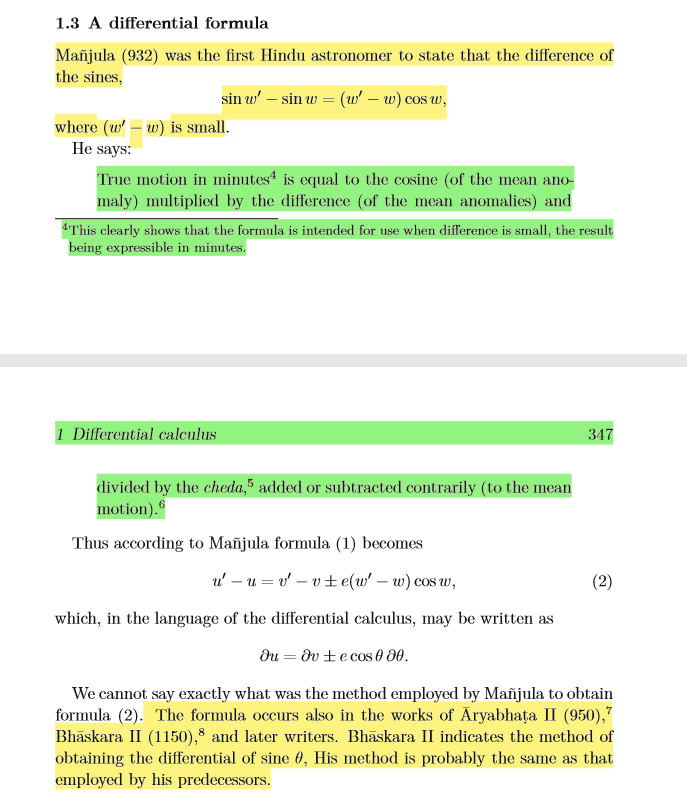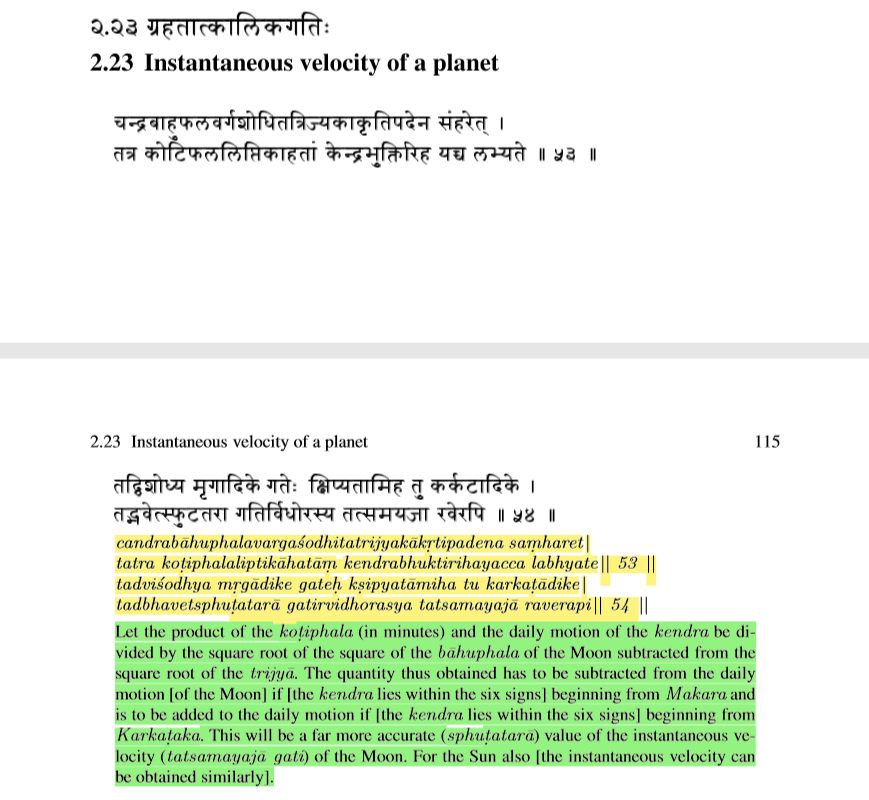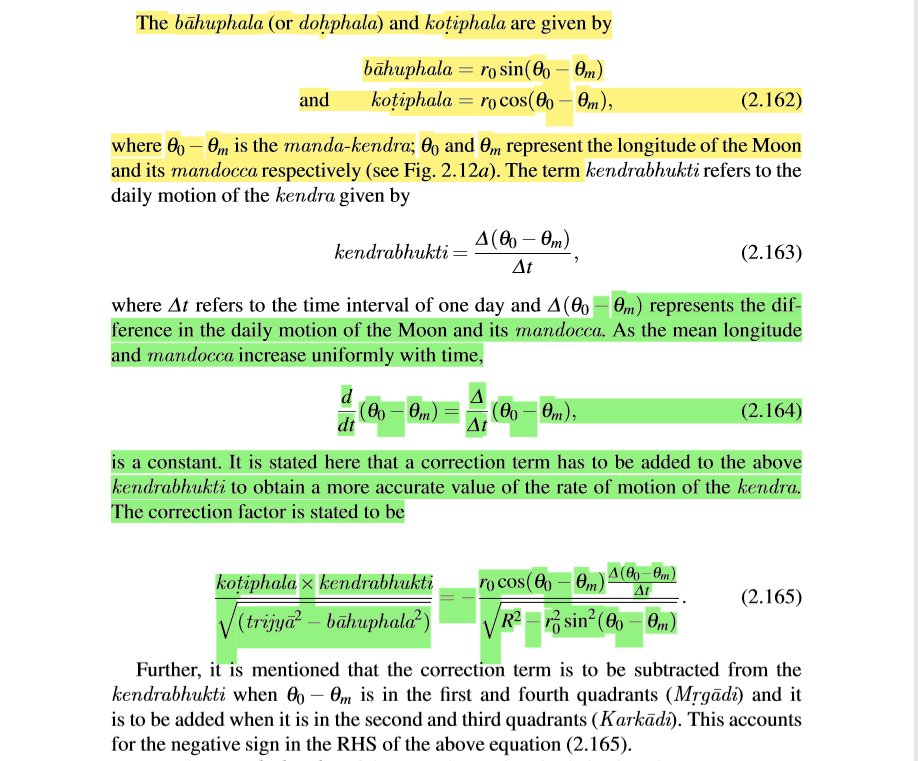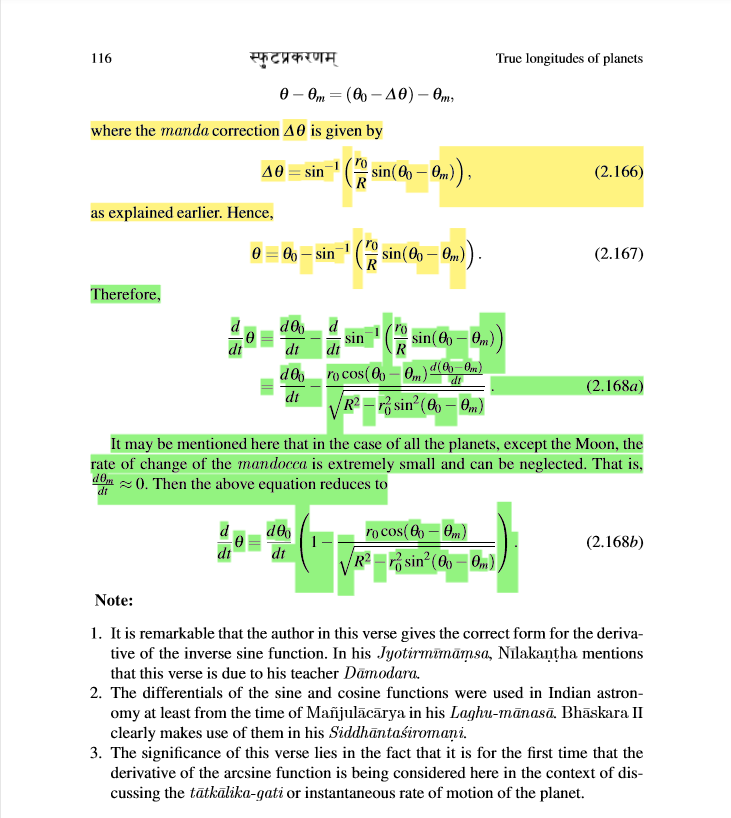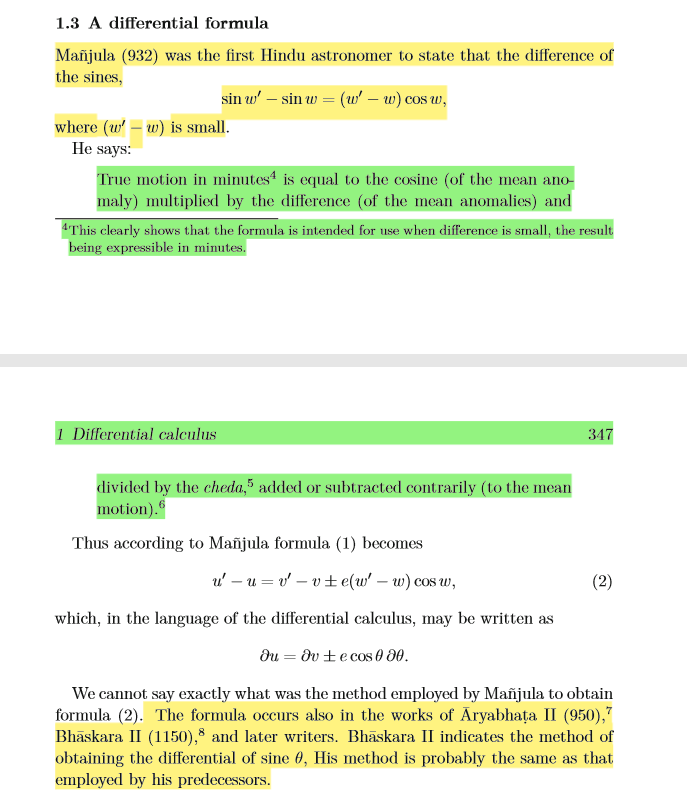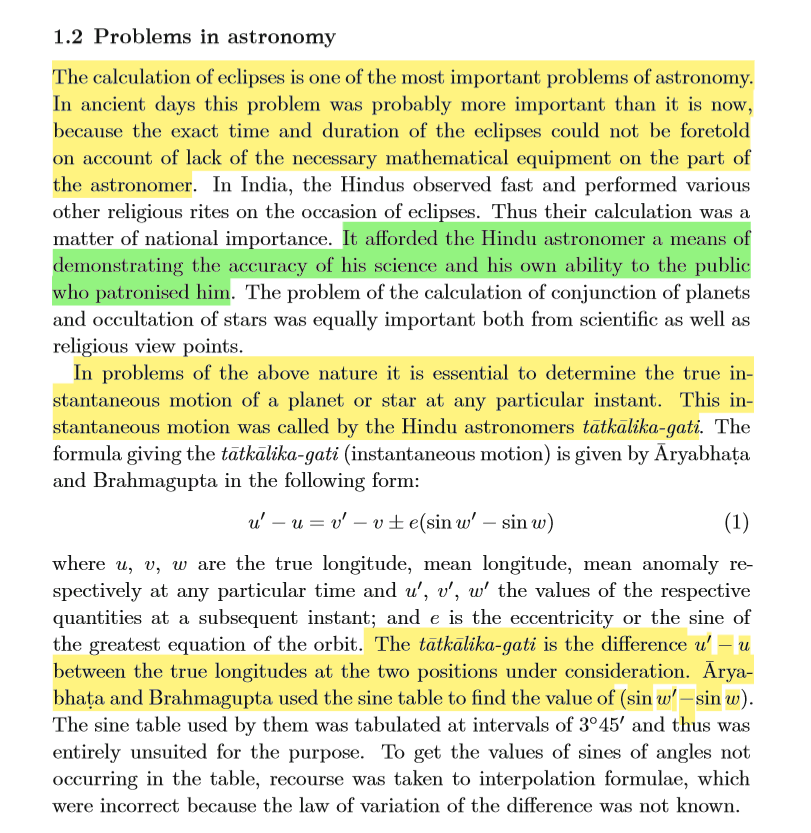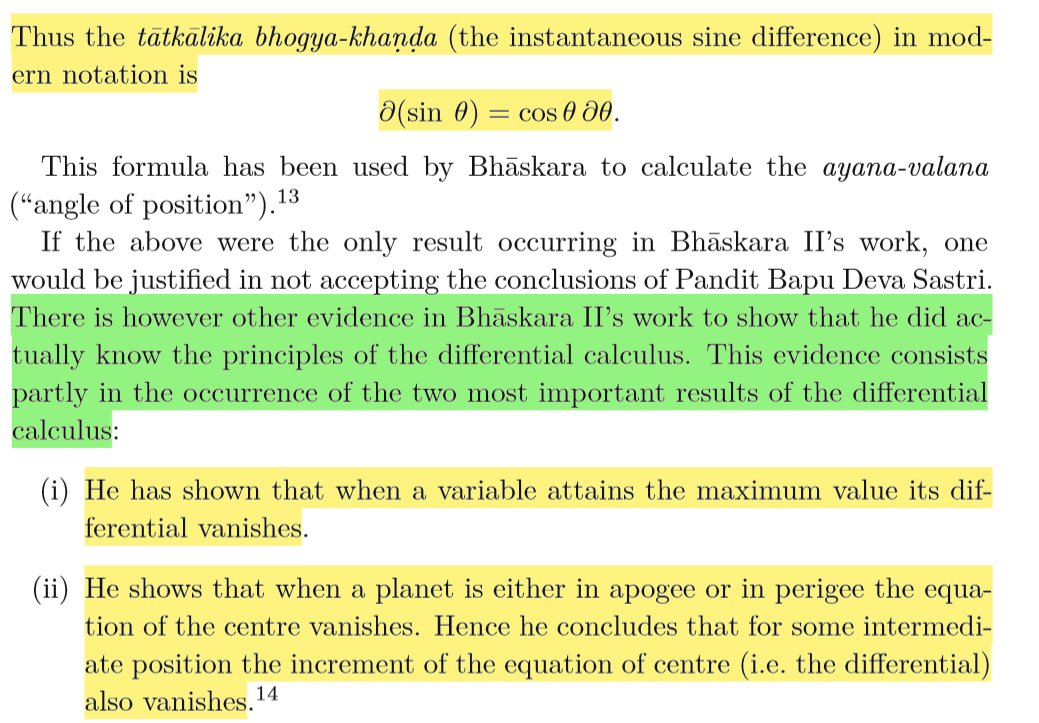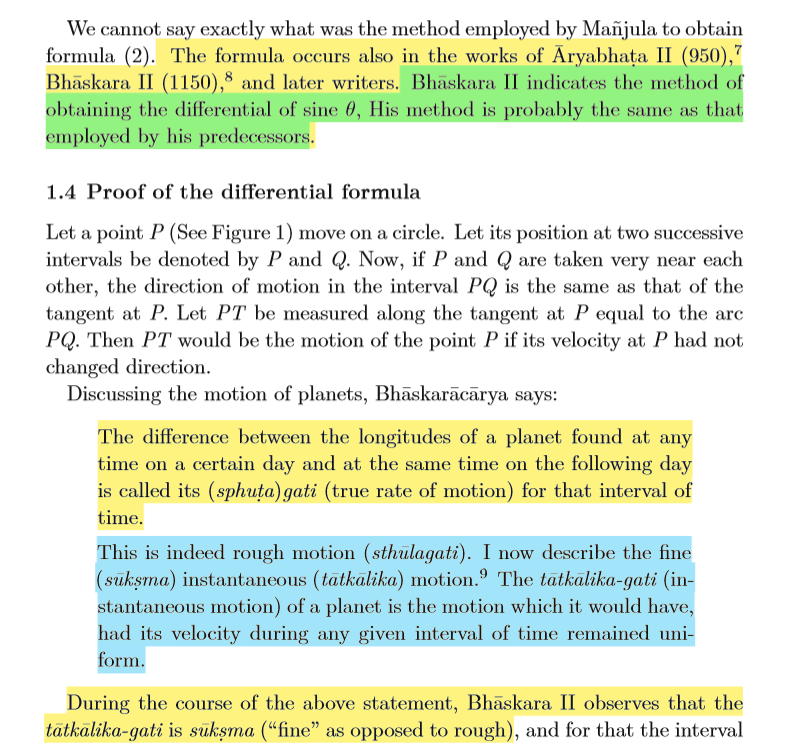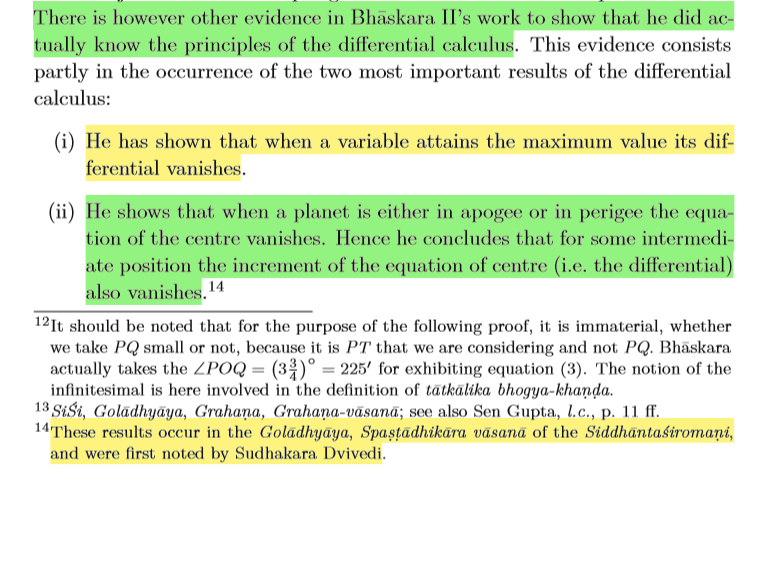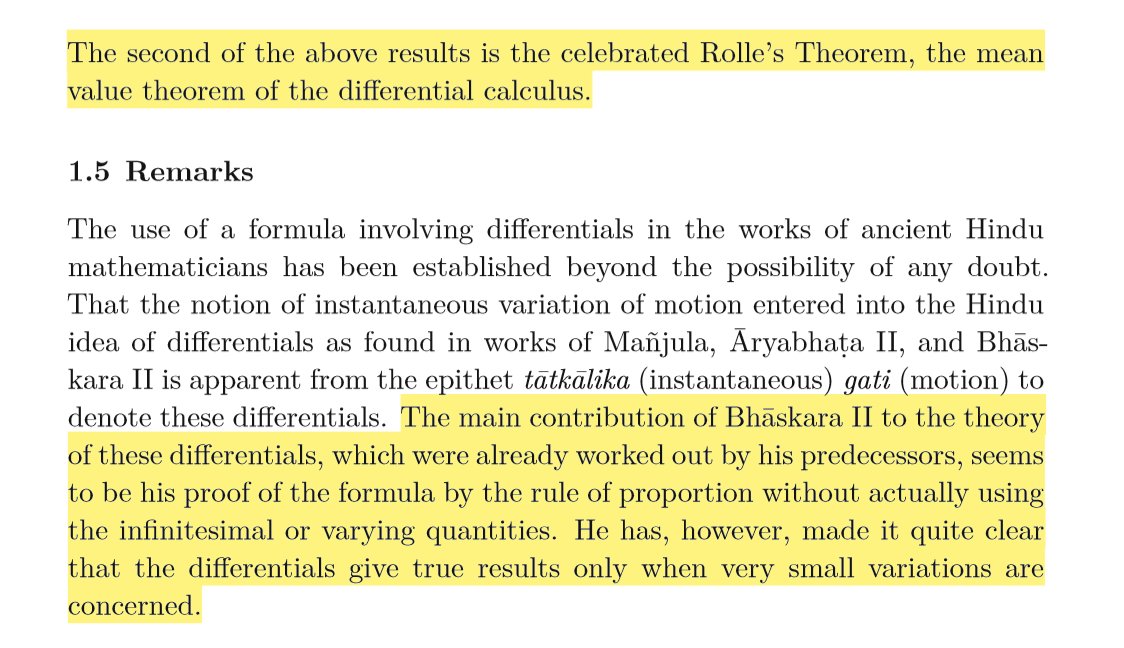The Principles of Differential Calculus were stated much earlier in India by Hindu Mathematicians in Sanskrit
Mañjula(932 CE) in his work Laghumānasa states the Differential Formula of the Sine Function in the following form :
Sinθ′−Sinθ = Cosθ(θ′−θ) where (θ′−θ) tends to 0 https://twitter.com/JoeAgneya/status/1198099977215471616">https://twitter.com/JoeAgneya...
Mañjula(932 CE) in his work Laghumānasa states the Differential Formula of the Sine Function in the following form :
Sinθ′−Sinθ = Cosθ(θ′−θ) where (θ′−θ) tends to 0 https://twitter.com/JoeAgneya/status/1198099977215471616">https://twitter.com/JoeAgneya...
Nīlakaṇṭha Somayājī- Jyeṣṭhadeva& #39;s Contemporary provides the Exact Form of the Derivative of the Inverse Sine Function in his Tantrasaṅgrāha
Tantrasaṅgrāha was composed in 1500 CE in Sanskrit at about the time Jyeṣṭhadeva- who authored Yuktibhāṣā was Born
@JoeAgneya
Tantrasaṅgrāha was composed in 1500 CE in Sanskrit at about the time Jyeṣṭhadeva- who authored Yuktibhāṣā was Born
@JoeAgneya
Not just Manjula, but his successors like Bhāskara II and Āryabhaṭa II in their works Siddhāntaśiromaṇi and Mahāsiddhānta respectively, state the Differential Formula of the Sine Function in the following form :
Sinθ′−Sinθ = Cosθ(θ′−θ) where (θ′−θ) tends to 0
Sinθ′−Sinθ = Cosθ(θ′−θ) where (θ′−θ) tends to 0
On a Side Note @JoeAgneya- in Telugu "Pagalaḍaṃ/Pagulu" (పగలడం/పగులు) means "To Shatter,To Divide" similar to "Pakuthi" meaning Half in Malayalam
Thus,we can indeed say the Principles of Integral Calculus were first stated in Highly-Sanskritised Malayalam in Yuktibhāṣā
Thus,we can indeed say the Principles of Integral Calculus were first stated in Highly-Sanskritised Malayalam in Yuktibhāṣā
All Engagement these set of tweets received is largely thanks to a Retweet by @TIinExile
Given that the sources of the excerpts have been inquired of-the details regarding the same are in the tweet below
Do access the books if possible, online : ) https://twitter.com/Herran_Ukkonen/status/1198341339252834304">https://twitter.com/Herran_Uk...
Given that the sources of the excerpts have been inquired of-the details regarding the same are in the tweet below
Do access the books if possible, online : ) https://twitter.com/Herran_Ukkonen/status/1198341339252834304">https://twitter.com/Herran_Uk...
Firstly,the Text in the Excerpt Below is a Translation of the Corresponding Portions of Laghumānasa of Mañjula-composed in Sanskrit
In Sanskrit,Jyā and Kotijyā of a Dhanu(Arc) correspond to Sine and Cosine-here they are Functions of an Arc than an Angle
https://twitter.com/mdrafi9111/status/1198878105227513857">https://twitter.com/mdrafi911...
In Sanskrit,Jyā and Kotijyā of a Dhanu(Arc) correspond to Sine and Cosine-here they are Functions of an Arc than an Angle
https://twitter.com/mdrafi9111/status/1198878105227513857">https://twitter.com/mdrafi911...
Now a few questions to answer
Did the Hindu Astronomers indeed know of Differential Calculus ?
They formulated Differential Forms of a few functions like the Sine Function,but did they Demonstrate an Idea of Limits ?
Did they formulate the Difference Quotient of Calculus ?
Did the Hindu Astronomers indeed know of Differential Calculus ?
They formulated Differential Forms of a few functions like the Sine Function,but did they Demonstrate an Idea of Limits ?
Did they formulate the Difference Quotient of Calculus ?
To answer these,we turn to the Chapter titled Spaṣṭādhikāra in the Gaṇitādhyāya Section of Bhāskaracārya& #39;s Magnum Opus- Siddhānta Śiromaṇi
Spaṣṭādhikāra deals with the Rectification by Bhāskara- of Calculations on Planetary Motion made by Astronomers who preceded Bhāskara
Spaṣṭādhikāra deals with the Rectification by Bhāskara- of Calculations on Planetary Motion made by Astronomers who preceded Bhāskara
Before cataloguing Bhāskara& #39;s Brilliance let us note the motivations of Hindu Astronomers that led to Differential Calculus
Calculation of the Time of Eclipses,Alignment of Planets and Occultation of Stars was of Vital Importance to deliberate on Tithis and Kālas within a Tithi
Calculation of the Time of Eclipses,Alignment of Planets and Occultation of Stars was of Vital Importance to deliberate on Tithis and Kālas within a Tithi
Precision in Calculations is of prime importance to Vaidika Karmakāṇḍins
This motivates the Determination of the True Instantaneous Motion of a Planet/Star at any Particular Moment
Hindu Astronomers referred to this Instantaneous Motion at a Given Moment as Tātkālikagati
This motivates the Determination of the True Instantaneous Motion of a Planet/Star at any Particular Moment
Hindu Astronomers referred to this Instantaneous Motion at a Given Moment as Tātkālikagati
The very notion of Instantaneous Motion is counter-intuitive
How does something move or possess velocity at a particular moment in time ?
What do motion or velocity even mean when time is frozen-when time is a constant and thus change in time or differential of time or dt=0 ?
How does something move or possess velocity at a particular moment in time ?
What do motion or velocity even mean when time is frozen-when time is a constant and thus change in time or differential of time or dt=0 ?
As to be expected-this idealisation of motion at a particular instant requires a mathematical tweaking
Rather than describing motion when time is frozen/at an instant- can we define motion and velocity between intervals of time when such intervals are infinitesimal in nature ?
Rather than describing motion when time is frozen/at an instant- can we define motion and velocity between intervals of time when such intervals are infinitesimal in nature ?
Limiting of Intervals of Time and defining a Body& #39;s Motion within this Differential Unit of Time is the Stepping Stone to Differential Calculus
Bhāskara II thus formulates the dichotomous terms of Sthūlagati and Tātkālikagati meaning Gross and Instantaneous Motions respectively
Bhāskara II thus formulates the dichotomous terms of Sthūlagati and Tātkālikagati meaning Gross and Instantaneous Motions respectively
What sets Bhāskara(1114 CE) apart from Mañjula(932 CE) and Āryabhaṭa II(950 CE)-who also mention of the Differential Form of the Sine Function ?
Bhāskara II not only mentions the Differential of Sine which he labels as Tātkālika Bhōgya-Khaṇḍa but also its Derivation and Proof
Bhāskara II not only mentions the Differential of Sine which he labels as Tātkālika Bhōgya-Khaṇḍa but also its Derivation and Proof

 Read on Twitter
Read on Twitter